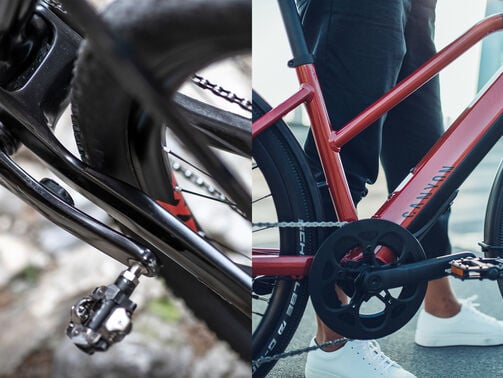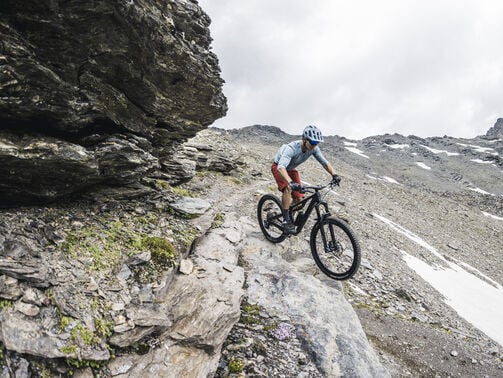How to choose cycling shoes
A comprehensive guide on how to choose your best cycling shoes for ultimate performance


There are a ton of footwear options for cycling out there, from lightweight racing slippers all the way to clipless sandals (yes, they exist), so it can be hard to know which are the best cycling shoes for you… or if you need them at all. This guide explains why cycling shoes are important and break down the different styles.
You don’t have to be a pro cyclist to wear cycling shoes. In fact, they can be beneficial for all types of riders, whether you’re an avid commuter or a hardcore mountain biker. However, it’s important to find the style of shoe that will work best with the type of riding you do. This guide will walk you through the different types of cycling shoes and help you pick the ones that will work best for you.

What are cycling shoes?
Biking shoes are nearly as varied as the riders who wear them, but there are some features that consistently make for a great pair of kicks.
Even if you only use a city bike for short distances, you’re probably aware that you need decent footwear. The shoe is one of the main connections between you and your bike, so you want that connection to be working as efficiently as possible.
Cycling shoes transfer power to your pedals with every pedal stroke. The stiffer the shoe’s sole, the more efficient the power transfer will be. If you wear trainers, tennis shoes or sneakers with soft soles, you will sacrifice some power due to the flex in the shoe. This might be fine for everyday riding, but if you’re training for a race or often ride long distances, then you will probably end up benefiting from a cycling-specific shoe for better support and power transfer while you’re on the bike.
Most of the time when cyclists talk about cycling shoes, they’re referring to clipless shoes, or ones that have fittings for cleats on the sole. However, there are flat cycling shoes as well, which may work better for you if you’re a mountain biker or simply aren’t a fan of being attached to your bike. Check our guide on the comparative merits of flat pedals vs clipless pedals if you have any doubts.
Do I really need dedicated shoes for cycling?
Good shoes are important for cycling, especially if you’re often riding long distances or if you’re training for a big event. That doesn’t mean you absolutely must buy bike-specific footwear, but we do recommend choosing a strong-soled shoe that gives you plenty of support. Cycling specific shoes will have a stiffer sole than a standard shoe, which helps to improve your power transfer and pedalling efficiency.
Even a flat cycling shoe will have a stiffer and often grippier sole than a conventional trainer or tennis shoe, which will help you to maintain better contact with your pedals. While riding in a standard sneaker is certainly possible, you will lose some power in the flex of the sole and you simply won’t have the same connection to your pedals that you have in a cycling-specific shoe. If your foot is constantly flexing or bending around the pedal through the shoe’s sole, this can also become really painful over time and lead to injury.
In short, while a cycling specific shoe isn’t strictly necessary, it is certainly recommended if you’re riding more than a few short ‘hops’ throughout a week. Cycling-specific shoes will help to improve your performance on the bike, but can also lead to a more comfortable, pain-free experience so you can focus on the things you love about riding bikes – and not your sore feet!

How do cycling shoes work?
We’ve briefly touched on what a clipless cycling shoe is, but how do they work and are there advantages over a flat shoe? Clipless cycling shoes, as we’ve mentioned, have fittings for cleats in the sole. These can be 2-bolt cleats, like Shimano’s SPD system, or 3-bolt cleats, which are more typically used by road cyclists. No matter what style of cleat you’re using, these cleats will clip into their corresponding pedals. The advantage of this is not only improved power transfer, but also that they allow you to use more of your pedal stroke. Rather than just pressing down, as you do with a standard flat shoe, clipless shoes allow you to pull up as well which is an added benefit on steep climbs. To release your shoe from your pedal in a clipless system, you simply have to twist your foot away from the bike and the cleat will come free.
As we’ve briefly covered already, cycling footwear falls into two broad categories, which can then be divided into the specific disciplines that each individual shoe model is best for. The two main categories are clipless shoes and flat shoes. Clipless shoes are designed to be worn with a cleat that clips into your pedal, while flat shoes are similar to a standard shoe but with a tougher and grippier sole.
If you often ride your mountain bike, you need durable and robust shoes. The soles must be stiff and have good grip, while the outer material must be weather-resistant. The shoe protects your feet from rain, mud, roots, rocks and all those other delightful challenges that mother nature has in store for us during a day on the trails. With MTB shoes, you can walk well and have sufficient grip, even in the deepest mud – great for everyone’s favourite, hike-a-bike.
Cross-country mountain bike shoes have an even stiffer sole than enduro shoes. A lot like road shoes, cross-country shoes aim for maximum power transfer in race situations. Enduro shoes on the other hand are much more comfortable and aim to offer secure grip on and off the pedal. This means that even within mountain biking shoes differ significantly.
When riding a road bike, maximum power transfer to the pedal is of utmost importance, followed closely by low overall weight. Subsequently, road bike shoes are extremely stiff and at the same time extremely light – often employing carbon fibre, or even graphene, to pursue these two dream characteristics.
It’s worth noting that because of the performance applications of some high-end cycling shoes, they may sacrifice a little bit of comfort in return for super-stiffness or very low weight. Much like the different design priorities of our endurance road bikes and our racing bikes, there are some cycling shoes best suited to going fast, and others better suited to going far.
Generally, road bike cleats are much bigger than their off-road equivalents. This ensures better power transfer from your legs to the bike, but does come at the most of mobility when you’re walking around. You’ve probably seen a TikTok or two about road cyclists clip-clopping their way into a cafe making an enormous racket as their cleats smack on the floor.
Take a mountain bike shoe and make it even more robust and flexible, give it more grip and improve the outer material. If the shoes protect against flying stones and meteorite impact (joke!), you have created a BMX and dirt bike shoe. You’ll have even more protection, grip and stability than a mountain bike shoe. You can also choose between flat pedal or clipless pedal compatibility.
So, there’s this new kind of cycling called gravel. Ever heard of it? You don’t need us to tell you that gravel as a discipline has exploded in the last few years, driven by the amazing fun and capability of bikes like the Canyon Grail and Grizl. There are also plenty of dedicated footwear options for the gravel rider these days.
Gravel shoes are a mixture of road bike and mountain bike shoes. They offer the optimal compromise between efficient power transfer and tough durability. With a reinforced outer material, they offer protection against rocks and dirt while remaining lightweight.
The sole is often stiff and firm without compromising on comfort. The soles of gravel shoes are designed in such a way that walking in them is also possible (useful for hike-a-bike-sections while riding). Rubber nubs and studs give you off-bike traction and necessary grip. This way, you can be reassured that you’ll be able to navigate your next gravel adventure or bikepacking trip easily.
If you’ve ever been bike touring, you know you don’t spend all of your time in the saddle. In fact, some of the bits we love most are the parts in between rides – from the morning croissant stop, to setting up the tent at your day’s destination.
Across a bike tour, you may walk or push your bike a few times, so the shoes you choose must be comfortable when you’re walking as well as when you’re riding. Slightly more flexible soles make perfect sense for cycle touring shoes.
Touring shoes often look like sneakers and have a reinforced toe area to prevent debris from hitting your toes. In addition, the sole has more grip than most trainers, so that your feet don’t slip off the pedals. Some touring shoes are compatible with clipless pedals, though you can hardly tell since the cleat is recessed into the sole.
Some call it a spin bike, others call it a stationary bike: the idea is it’s a fun workout without the need to ride outside in bad weather or along busy roads. Spinning is efficient cardio training and can help your existing training if you’re a regular cyclist.
Spin bikes often have double-sided pedals, which have a normal platform with loops on one side while the other side has a clipless system. You can use the looped side with normal trainers, however the other side requires clipless pedals. Using clipless pedals for indoor training, while not necessary, will improve your power output and can help you to get a better workout.
It’s best to choose a shoe that fits well, is extremely breathable given the extra heat generated by exercising indoors, and has a stiff sole for good power transfer. Now let’s push for the burn!
SPD stands for Shimano Pedalling Dynamics. The clipless system has been on the market since 1988 and comes from the well-known bicycle component manufacturer, Shimano. The system is very widespread, especially in the mountain bike sector. SPDs allow you to walk in your shoes thanks to a recessed cleat that is sunk into the sole. The cleat is much smaller and therefore resists mud a lot better than a larger cleat.
If you ride different bikes e.g. a cross-country mountain bike, a gravel bike and a road bike and you don’t want three different pairs of shoes, an SPD system can be a good solution. SPDs can also be beneficial for bicycle touring or bikepacking as their walkability means that you only need one pair of shoes.

How should cycling shoes fit and how to find the right size?
The main advantage of cycling shoes over other shoes is the improved power transfer to the pedal. To ensure this, the shoe needs to fit well. Your heel should be secured within the shoe and not slip out. The arch of the foot should be sufficiently supported, too. Though the foot should be secure, if the shoe is too tight it can cause discomfort, injury and a decline in overall performance. Luckily many shoe brands offer half sizes in cycling shoes to allow greater flexibility.
When buying cycling shoes, the correct size can differ from the shoe size of your everyday shoes. Some manufacturers give the foot length measurement to ensure you choose the right size. In order to achieve optimal comfort and to avoid pressure points, the width is also crucial for a comfortable cycling shoe. Tip: check if the manufacturer offers different widths.
Some cyclists use insoles in their cycling shoes to further aid comfort. Insoles have varying purposes: carbon insoles for example improve power transfer from the shoe to the pedal. Other insoles correct foot posture thus preventing injury.
Are indoor cycling shoes the same as outdoor?
As we’ve already covered, cycling shoes are designed to excel in their specific discipline and have features that make them best suited for the kind of riding you’ll be doing. But what makes indoor cycling shoes different? You can certainly use any shoe that works with the clipless system on your spin bike for indoor training, but there are some factors to consider when looking for an indoor-specific shoe.
Indoor cycling shoes will typically be made of more breathable material to allow better air flow, and because they don’t need to keep out the weather. As many spin bikes use the SPD system, most indoor cycling shoes will be lighter than a standard SPD shoe, which will make indoor training easier and smoother.
If you’re planning on using your shoes for indoor and outdoor cycling, then any outdoor shoe that works with the pedals on both of your bikes will do just fine. However, if you’re planning on sticking exclusively to spin class or home training, then indoor cycling-specific shoes will work best for you.

Tips on cleaning cycling shoes
As your shoes are the closest part of you to the ground while you’re on the bike, they can also be the hardest part to keep clean, especially if you’re sporting a classic white road cycling shoe. Here are some tips to keep your shoes and cleats clean so that you can wear them for longer.
• If you’re a mountain or gravel biker, its good practice to regularly check the bottoms of your shoes for any rocks or other debris that might get stuck between the studs and your cleats.
• After riding in the rain, stuff your shoes with newspaper or paper towel to dry out the insides. Make sure to dry off the bolts and cleats, especially if they are metal, to prevent rust and extend the life of your cleats.
• If your shoes get particularly muddy, let them dry off so that you can easily brush off the mud once its dried. Any remaining stains can be gently wiped off with a damp rag.
Getting into the habit of checking and cleaning your cycling shoes after each ride can help to prolong their lifespan and you’ll also be able to pick up on when your cleats need replacing.
Cycling shoes
Did this article help?
Thank you for your feedback




